July 12, 2021
Gardening for Science
A hidden world of care and scientific rigor
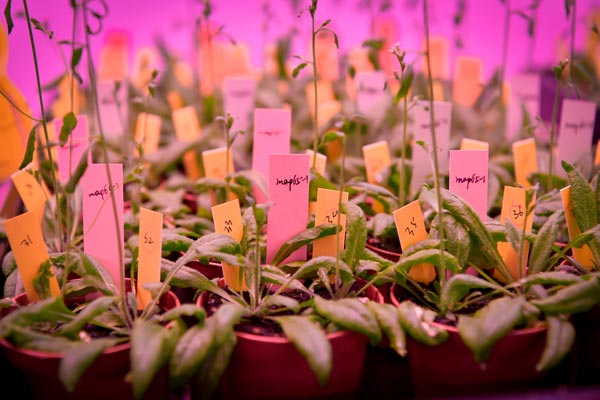
In one of the basements at the Institute of Science and Technology (IST) Austria, mutants are growing. But instead of monsters, these are small plants serving as living subjects for science. This is the realm of Dorota Jaworska, the Institute’s plant facility technician, taking great care of thousands of little experiments.
Some fields of biology require studying living subjects. At IST Austria, scientists use Arabidopsis thaliana, also called thale cress, to experiment on. Taking care of thousands of these plants is a complex undertaking, but Dorota Jaworska is up to the task.
“I’ve been a plant person all my life,” Dorota muses. She is sitting on the terrace overlooking the campus pond during a break on a hot summer day. In the white building behind her, Arabidopsis thaliana grows in several windowless rooms. She is taking us with her on one day in the service of gardening for science.
Inconspicuous but Crucial
“The first thing I do in the morning is to check on all the plants and whether anything unforeseen has happened overnight,” Dorota says, standing in one of the in vivo rooms where the plants live. She gestures to the shelves lining the walls of the small room. They are stacked with a myriad of small inconspicuous plants. “We have to closely control the humidity, the temperature, and the lighting in these rooms, to provide stable and reproducible conditions for the experiments,” she explains.
While not being an eye-catching plant, Arabidopsis thaliana plays a crucial role in plant biology. First selected for this use at the beginning of the twentieth century by the German scientist Friedrich Laibach, it quite literally grew to become the standard for genetic experiments on plants. It can be cultivated quickly, matures in just six weeks, and produces a high yield of tiny seeds.
After the first check, Dorota continues with watering the plants. “Watering is quite a science unto itself,” she laughs. “It is very much based on experience because if I were to measure the soil humidity for each plant, I wouldn’t be done by the end of the day dealing with up to 15,000 plants.”
Every plant is important to her, but each tray of plants is used for a different experimental purpose. To Dorota, the plants are anonymous, so she needs the help of the scientists working with her to take care of them all.
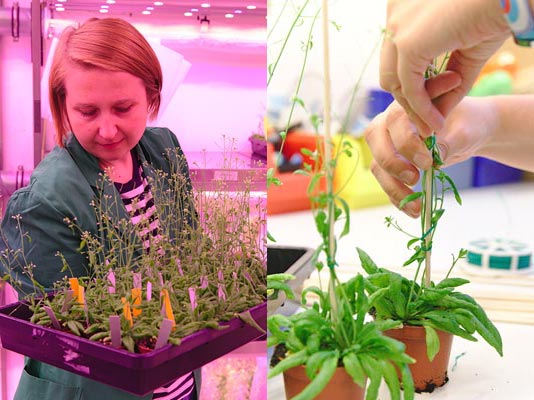
Close Collaboration
“Maintaining the plant facility is not a job for one person alone,” Dorota says. “I am working closely with up to 30 scientists from the Benková and the Friml group. It can be a lot of work to coordinate everyone, but we have a great community here.”
These two research groups – led by Eva Benková and Jiří Friml – study the developmental biology and cell biology of plants. For example, they look into how plants find nitrogen in the soil, how plants heal their wounds, or how plants can feel gravity.
Dorota cautions, “For all this research, we need to follow strict protocols to ensure there is no contamination and the experiments are reproducible by other labs.” Because the Arabidopsis thaliana plants in this facility are genetically modified, none can leave their rooms without being enclosed in a special sealed box. “We also work with IST Austria’s Lab Support Facility to sterilize all the organic waste and even the wastewater produced in this facility.”
IST Austria’s plant facility is not only used for science but both Dorota and the scientists there contribute to the Institute’s yearly Open Campus day showing off their plants to the visiting public. “It is nice to show how science is done in practice and to share our passion for it,” Dorota says. “We have even done projects with school children who grew plants from seeds to do experiments on them.”
Next, she directs us into a special room filled with peculiar lights where her floral subjects of science start their life.
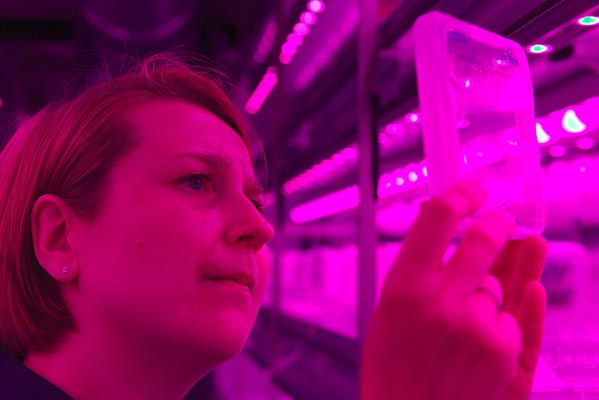
From Seed to Harvest
Drenched in pink light, the in vitro room is where the seedlings of Arabidopsis thaliana grow. “Here, we use LEDs for special lighting with only blue and red light to control the plants’ growth,” Dorota explains while handling the delicate transparent plates containing the tiny plants and a substrate of agar used to provide the plants with nutrients. The scientists use special lighting to influence the plants’ growth rate, leaf and root formation, and many other aspects of their development.
Once the seedlings are big enough, they are transported to a separate room for potting in their trays. “This is the dirty part of the job. I sometimes help the scientists, but mostly I have to focus on plant health management, coordinate procedures, and make sure that everything is well stocked,” Dorota recounts her daily routine. “We then either place the plants into incubators, which look like warm and brightly lit fridges, or they are placed in the in vivo rooms.”
Once the plants reach full maturity after six weeks, they are again taken into another room for harvesting. Their seeds are tiny specs smaller than a pinhead. “We collect many thousands of them and have to be very careful not to mix them up.”
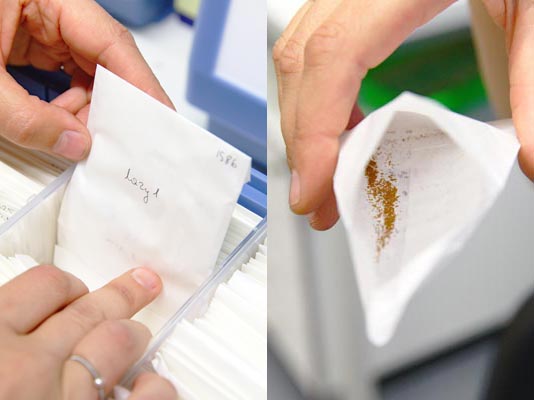
After harvesting, the seeds are stored in a seed bank to be kept for many years for future use. Each lab working with Arabidopsis thaliana has its own genetic lines – a family tree containing plants with specific features like size, look, or resilience against temperature changes and droughts. Somewhat similar to collectors’ items or trading cards, scientists also exchange seeds of different lines to compare and study them.
“We have over 5,000 different genetic lines in our seed bank summing up to millions of individual seeds,” Dorota explains. “We often send them to other labs we collaborate with and receive samples of their lines.”
While caring for the plants and managing the people in the facility, she does not lose sight of the initial calling that brought her to this job.
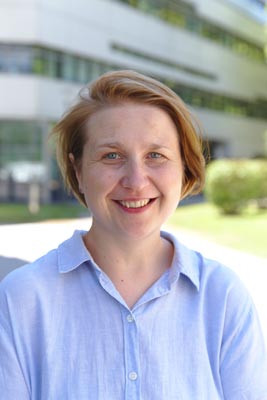
A Planted Life
Growing up in the countryside in the small city of Krasnystaw in eastern Poland, Dorota then studied landscape architecture and went to Scotland to work in a contemporary art sculpture garden. “I have always been interested in plants and in caring for them,” she recalls. “In the sculpture garden, we looked at plants from an architectural and artistic perspective. Later, when I joined the botanical garden in Edinburgh working in the herbarium with dry specimen, I moved into a more scientific field.”
When she moved to Austria in 2016, she found a job at the plant facility at IST Austria. “In the five years I have been here, many things have changed. We not only expanded the facility but also conducted experiments with different climate, soil, and lighting conditions,” she recounts. “It was risky doing this at a running facility, and we had to work closely with all the scientists involved, but it turned out great.”
Dorota admits that it can be a challenging job, too. “I am supporting so many people – each one with their project that is important to them – and I try to take equal care of so many plants. But I am glad to have built great connections with the scientists and, also, to get to know people from many different countries and wakes of life. First of all, my customers are the plants, but behind the plants are my colleagues. So if the plants are happy, my colleagues are too.” Asked whether she also takes care of plants at home, she laughs. “I only have one cactus at home. That is enough.”



